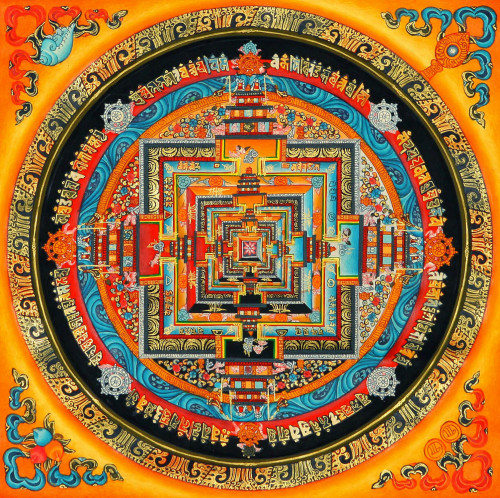#nagarjuna
Advaita Vedanta and Buddhism: Andrew Holecek in conversation with Swami Sarvapriyananda
A fantastic exploration of the finer points of non-dual philosophy.
“Living wherever, living however, living whenever, each person contains many possible persons. Every day, the ruling system places our worst characteristics at center stage, condemning our best to languish behind the backdrop. The system of power is not in the least eternal. We may be badly made, but we’re not finished, and it’s the adventure of changing reality and changing ourselves that makes our blip in the history of the universe
worthwhile…”
— (p. 329) Eduardo Galeano (2000) Upside down: A primer for the looking-glass world
Emptiness is the interdependence of all phenomena. In the smallest of particles and seeds are infinite possibilities.
Continued⇒https://unityinplurality.blogspot.com/2019/09/intro-to-emptiness.html
Post link
Enter the void. By this, we don’t mean absolute oblivion or total annihilation, but a complete transformation of all one previously knew that will nonetheless prove to be revolutionary.
Śūnyatā, by the Buddha’s definition, is a radical emptiness that transforms beings from the inside out.
Continued⇒https://unityinplurality.blogspot.com/2019/09/intro-to-emptiness.html
The Mind in Indian Philosophy II: Self and World
Last time, in Part I, we discussed how our minds represent things under the limiting conditions of sensibility. We began with the arguments of Kant on this topic; his philosophy of mind has many similarities with some much-older classical Indian philosophy.
Today we discuss some Indian philosophy of the self.
According to some philosophers, limitations of ourselves limit our knowledge of the external world. The basic idea is that if you change as a definite person—or if you never existed at all—the objects you perceive change as well because how you think, dream, and speak about objects is disunified.
For Arindam Chakrabarti (author of Realisms Interlinked; pictured), subjects and objects are intimately connected. A single ‘I’ of a mind must unify experiences over time to give nature to external reality (Nyāya-school arguments). A stable self achieves unification of objects by sustaining an objective time-order, carrying them in a coherent world in continued experience. So if a mind substantively changes and the single-self perspective dissipates, the objects housed in prior experience lose their structure.
Chakrabarti claims the mind can track the world because what is real about the world has the very nature of being knowable. Antirealists disagree and say this would render reality a product of the mind—a claim realists want to avoid! Sidestepping this challenge, Chakrabarti argues that subjects and objects must both be real for there to be real objects.
So are persisting subjects—selves—real?
Abhidharma Buddhist Vasubandhu claimed selves reduce to entities called ‘dhamas’. But these selves only hold ‘conventional’ existences. Pudgalavādins go further: they argue for the actual reality of persons. Nāgārjuna, in contrast, denied the existence of any fundamental object at all, including the self.
If there is no persistent self, there is no stable reality. As per Hume’s bundle theory, selves are just bundles of properties coming together. Objects, then, are bundles of properties coming together as well, appearing to us differently each time in representation under the limiting conditions of sensibility.
So here’s a scary thought.
Look at something you love, say, your pet. Ask: have you changed from five years or even 10 minutes ago? If you have, you better start firming up your reality; else you may have just lost a pet. The upshot is at least you gained a bundle of properties—and again; and again …
Post link
The Mind in Indian Philosophy I: Before Kant
It was Kant who said, in Critique of Pure Reason, that ‘all objects of an experience possible for us are nothing but appearances’. What did he mean? Well, cognition requires intuition but intuition is limited: it presents appearances, not ‘things in themselves’.
In claiming so, Kant tied metaphysics to epistemology, appealing to a distinction between objects drawn from our conceptual resources and the things we cannot know.
‘[T]he transcendental object that lies at the basis of appearances […] is and remains for us inscrutable; for although the thing itself is indeed given, we just do not have insight into it.’
However, Kant, by a long stretch, wasn’t the first philosopher to argue along these lines. Roots can be traced to classical Indian philosophy. In the Nyāya, Vedānta, and Buddhist traditions, for example, the mind’s connection to the external world has long been questioned.
From science and in our own lives, we know that mental faculties create different ‘appearances’ between us. Apparently, on average, an orange object appears redder to males and grass is greener to females; boa constrictors have infrared vision; that dress is either gold and white or blue and black. However, perhaps there is a true nature of each of these things, even if it cannot be cognised and known (Kant).
According to Nāgārjuna (b. 150 AD; pictured), a Madhyamaka Buddhist, there isn’t. Reality is empty and by banishing ‘objective thought’ upon our reflections we’re able realise this ‘ultimate truth’.
This Madhyamakan route can still be noncommittal: through it we remain sceptical about the world, neither ascribing reality nor rejecting reality in our beliefs (a view which may have inspired Pyrrho).
According to many other philosophers, though, it is possible to conceive of real ‘things’, committing one to realism. It might just be that the mind only provides windows with restricted views (cf. Locke’s distinction of primary and secondary qualities).
With our descriptions of the world, like in physics, we might just track certain patterns and structures without truly understanding the ‘why’s of reality (e.g., particles can be waves and in infinite places at once).
What do you think?
(Painting [c. 1750]: Nāgārjuna with Mahasiddhas [cropped]. [Rubin Museum of Art])
Post link
Brahmāstra






Part One : Shiva




